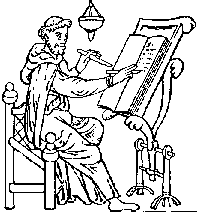
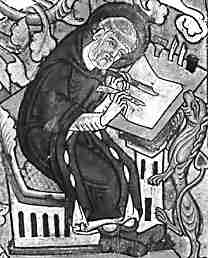
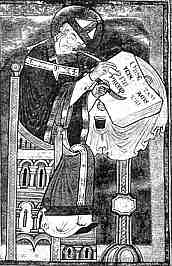
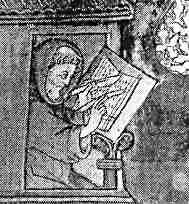
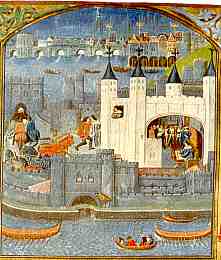
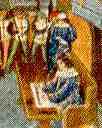
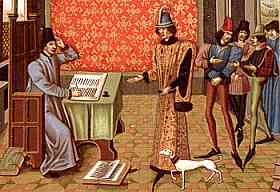
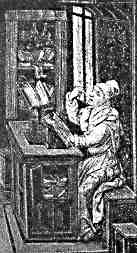

If you are looking at this page without frames, there is more information about medieval writing to be found by going to the home page (framed) or the site map (no frames).
| The Material Culture of Literacy | ||||
| Scribes, readers and students are much depicted in medieval art, particularly in illuminated manuscripts themselves. These depictions survive much more prolifically than the material items, apart from books, which they used for reading and writing. Making allowances for artistic conventions, they can tell us something about the mechanics of literate practice, as well as the valuation of literacy through the nature of its material correlates. | ||||
 |
From his tonsure and habit, our scribe here is a monk of the old tradition. He holds his quill and knife, the practical tools of his trade. His sloping writing desk, even if ingeniously cantilevered, looks a little topheavy, but it does show how he can use his tools to write without leaning all over the page and smudging the ink. He is shown with a lamp above his head. He is not shown copying from an exemplar, but they seldom are. It looks as if he is sitting on a three legged stool, but perhaps, like Mrs Roger Rabbit, it's just drawn that way. | |||
| The above little doodle of a medieval scribe, extracted from an old schoolbook, derives, I believe, from a 13th century manuscript illustration in the Bodleian Library. Since we are not permitted to reproduce him in colour from a slide, this limp imitation will have to do. | ||||
 |
This figure of St Jerome, from a historiated initial in a 12th century Bible, gives a meticulous picture of the tools of the scribe. The chair and writing desk might be overly architectural, but the desk is on a slope. He holds his quill pen in the right hand and his special knife in the left. Arranged along the top of his writing desk are his ink horn and an assortment of other tools, which could be scrapers, buffers or spare pens. He appears to be writing on unbound sheets. The very stylised lion, symbol of the saint, is there for iconographic, not ethnographic, purposes, so we have a combination of symbolic and representational depiction. | |||
| Part of a historiated initial from the beginning of a Bible of 1148, from the Premonstratensian monastery of St Maria de Parc, near Louvain, Belgium (British Library, add. ms. 14788), by permission of the British Library. | ||||
 |
The image of St Dunstan at left also contains a mixture of symbolic and representational elements. The scribe's chair and writing desk are very stylised, with architectural details, and he is sitting down in his full mass vestments, including mitre and pallium. It was a common convention of medieval art to depict people with their significata of rank, whatever they were supposed to be doing, so it appears that archbishops never took off their mitres or kings their crowns. He holds his pen and knife, and his ink horn sits below the book. He is depicted writing in very large capital letters into what looks like a fully bound codex which has been unwrapped from a cloth wrapper. This may have been what it looked like when it was finished, but the more likely practicality was that the writing was done on quires of unbound leaves. | |||
| Unfortunately scruffy reproduction of St Dunstan from an unidentified manuscript. It is a very famous image, so no doubt somebody out there will recognise it. | ||||
 |
A common convention, rather than depicting every realistic detail, was to reduce the image of the tools of the scribe to the essential recognisable details; the pen, knife and sloping desk. These are the iconic significata of the writer. This particular image shows the scribe in a sort of little box in a forest, in order to indicate that he was a hermit. | |||
| Miniature of the author the the religious poem Miserere, in a 13th century volume of the work (Arsenal, ms. 3142). (From Bédier and Hazard 1923) | ||||
| In the later medieval period a slightly different image appears, partly created by a more naturalistic form of depiction, and partly by the differing nature of the scribes depicted. Instead of monks in ascetic surroundings, we find lay authors in their comfortable studies, or sometimes prisons. | ||||
 |
This miniature of the Tower of London, from a manuscript of the poems of Charles, Duke of Orleans, must be one of the most reproduced medieval images. Usually it is shown because of its topographic depiction of the city of London, with the Tower in the foreground, tall timber framed buildings in the middle and London Bridge in the background, with little boats chuffing around on the Thames. However, one large wall of the White Tower has been removed to show the duke, prisoner from the battle of Agincourt, writing his poems under the gaze of his jailors. He sits on a long wooden bench at a plain horizontal table. | |||
| Miniature of Charles, duke of Orleans in the Tower of London, from a Flemish manuscript of around 1500 (British Library, Royal 16 F, f.ii). | ||||
| Don't worry about him though. They would have fed him well. He had French visitors. They were hoping to get a lot of money for him. |
 |
|||
 |
 |
|||
| Two depictions of Froissart writing. That on the left is after a Burgundian manuscript of around 1460 (Bibliothèque de l'Arsenal, ms 5190) The one on the right is from a 14th century French manuscript (Bibliothèque Nationale). (From Lanson 1923) | ||||
| Froissart is also shown at a flat horizontal writing desk. The left hand depiction shows him writing directly on the horizontal surface with his ink pot in front of him and books scattered around. On the right, he is using a sloping stand and apparently has an exemplar perched on a tall stand on the table beside him. A shelf of books stands in the background. In the left depiction, his hand is clutched to his head in distress as an important visitor has just interrupted him, and in those days they didn't just ring on the mobile phone, they turned up with a troop of retainers and the dog and expected bed and board for the lot. | ||||
 |
This late medieval author scribbling away in his study is shown with the same basic accoutrements of flat desk with sloping stand. He also has shelves and chests overflowing with books and a desk as messy as mine. You can't really see what is on the desk, but, in the abscence of coffee cups at that time, there may be a couple of empty mead glasses among the scribal clutter. The culture of writing has moved from the spare and ascetic to the busy and luscious. | |||
| Small miniature from a set on book culture, from a manuscript in the Bibliothèque de Cambrai. (From Lanson 1923) | ||||
|
|
||||
|
If you are looking at this page without frames, there is more information about medieval writing to be found by going to the home page (framed) or the site map (no frames). |
||||